
Tomás Ortín, researcher at the Institute of Theoretical Physics (IFT), will address the connection between theoretical physics and mathematics in the context of black holes this Friday 13 December at 12:00 at the Centre for Theoretical Physics and Mathematics (CFTMAT). In his talk, ‘Some new results on symmetries, conserved charges and black-hole physics’, he will show how Noether’s Theorems and Gauss’s Laws explain the connection between conserved quantities and the thermodynamic properties of black holes. This is a joint event between the IFT and the Institute of Mathematical Sciences (ICMAT), which is held every year to encourage interdisciplinary collaboration between physicists and mathematicians to tackle fundamental enigmas of nature.
The Institute of Mathematical Sciences (ICMAT) and the Institute of Theoretical Physics (IFT UAM-CSIC) are holding, as they do every December, their traditional joint colloquium, which on this occasion will be attended by the physicist Tomás Ortín, researcher at the IFT. With the title ‘New results on symmetries, conserved charges and the physics of black holes’, he will present an overview of these concepts, which establish deep connections between theoretical physics and mathematics, and some of their applications in the context of the physics of black holes, on 13 December at 12:00 in the Aula Azul of the Centre for Theoretical Physics and Mathematics (CFTMAT).
In this relationship, Noether’s theorems and Gaussian laws play a fundamental role, allowing the establishment of results such as the (non-)existence and ‘no-hair’ theorems and Smarr’s formula. The former establish that black holes are described by a few conserved quantities: their mass, their angular momentum and their electric charge. The Smarr formula, on the other hand, links these characteristics of the black hole to its thermodynamic properties.
The famous Noether theorems are one of the pillars of modern physics. The first of these, which is usually referred to as Noether’s theorem (in the singular), states that each global symmetry of a physical system corresponds to a conserved quantity (called charge). This implies that, for example, if a mechanical system is time invariant (i.e., its physical laws do not change with time, it is symmetric with respect to time), then there must be a conserved quantity related to that symmetry: energy.
The second of these, less well known, but as profound as the first, describes what happens when there are local (or gauge) symmetries. In this case it is more difficult to define the conserved quantities, but it can be shown that they satisfy the so-called Gaussian laws. These are extraordinarily important properties which indicate that the conserved quantity only depends on the topology of the surface to which it has been assigned and not on its shape (geometry). The so-called Smarr formula is derived from them.
The Smarr formula relates the conserved quantities of a black hole (mass, electric charge, angular momentum) to its thermodynamic properties (Hawking temperature in entropy). The former are defined at very distant surfaces of the black hole while the latter are defined at its event horizon. Tomás Ortín has found a generalisation of this formula, concerning the so-called Komar charge.
On the other hand, the ‘no-hair’ theorem – which, despite its name, is not a mathematically proven statement, but the result of observations and beliefs of theoretical physicists – states that black holes are completely and exclusively described by a small number of conserved charges: their mass, their angular momentum and their electric charge.
Ortín will also explain the new constructions of geometric charges that he has been investigating together with other collaborators. These charges, which are still in an exploratory phase, may be related to advanced concepts such as the dual graviton. Ortín will share some of the most recent advances, stressing that these new approaches may have wider implications for theoretical physics and mathematics applied to general relativity.
ICMAT-IFT Colloquium – Some new results on symmetries, conserved charges and black-hole physics, by Tomás Ortín Miguel (IFT).
Friday 13 December 2024 – 12:00, in the Aula Azul, ICMAT.
Abstract:
Charges, whether they conserved or not, are a basic tool used to characterize states or configurations in fundamental physics. In this talk, always from a classical (i.e. non-quantum) point of view, I will first review the standard lore on conserved charges to then focus on the construction of charges (some of them, purely geometrical) that only satisfy Gauss laws and their use in the context of black-hole physics to derive Smarr formulas and no-hair therems.
Tomás Ortín
Tomás Ortín is Research Professor at the Consejo Superior de Investigaciones Científicas (CSIC) and member of the Instituto de Física Teórica (IFT-UAM/CSIC). His career stands out for his contribution to the field of theoretical physics, in particular in the study of string theories and gauge theory.
A graduate in Physics from the University of Valladolid, he specialised in Theoretical Physics at the Autonomous University of Madrid, where he also obtained his PhD on string theories. He was then a postdoctoral researcher at Stanford University and the University of London. He then joined, in various positions, the Theory Department of the European Laboratory for Particle Physics (CERN).
This content has been automatically translated. The original text may differ slightly
